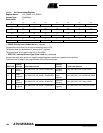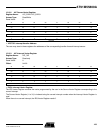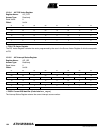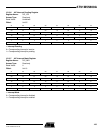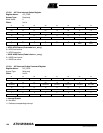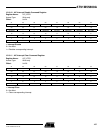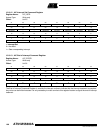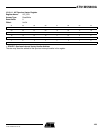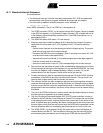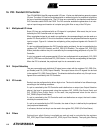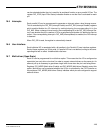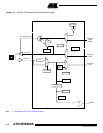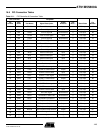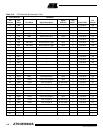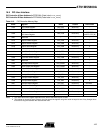
110
1745D–ATARM–04-Nov-05
AT91M55800A
15.11 Standard Interrupt Sequence
It is assumed that:
• The Advanced Interrupt Controller has been programmed, AIC_SVR are loaded with
corresponding interrupt service routine addresses and interrupts are enabled.
• The Instruction at address 0x18(IRQ exception vector address) is
ldr pc, [pc, #-&F20]
When NIRQ is asserted, if the bit I of CPSR is 0, the sequence is:
1. The CPSR is stored in SPSR_irq, the current value of the Program Counter is loaded
in the IRQ link register (r14_irq) and the Program Counter (r15) is loaded with 0x18.
In the following cycle during fetch at address 0x1C, the ARM Core adjusts r14_irq,
decrementing it by 4.
2. The ARM Core enters IRQ mode, if it is not already.
3. When the instruction loaded at address 0x18 is executed, the Program Counter is
loaded with the value read in AIC_IVR. Reading the AIC_IVR has the following
effects:
– Set the current interrupt to be the pending one with the highest priority. The current
level is the priority level of the current interrupt.
– De-assert the NIRQ line on the processor. (Even if vectoring is not used, AIC_IVR
must be read in order to de-assert NIRQ)
– Automatically clear the interrupt, if it has been programmed to be edge-triggered
– Push the current level on to the stack
– Return the value written in the AIC_SVR corresponding to the current interrupt
4. The previous step has effect to branch to the corresponding interrupt service routine.
This should start by saving the Link Register(r14_irq) and the SPSR(SPSR_irq). Note
that the Link Register must be decremented by 4 when it is saved, if it is to be
restored directly into the Program Counter at the end of the interrupt.
5. Further interrupts can then be unmasked by clearing the I bit in the CPSR, allowing
re-assertion of the NIRQ to be taken into account by the core. This can occur if an
interrupt with a higher priority than the current one occurs.
6. The Interrupt Handler can then proceed as required, saving the registers which are
used and restoring them at the end. During this phase, an interrupt of priority higher
than the current level will restart the sequence from step 1. Note that if the interrupt is
programmed to be level sensitive, the source of the interrupt must be cleared during
this phase.
7. The I bit in the CPSR must be set in order to mask interrupts before exiting, to ensure
that the interrupt is completed in an orderly manner.
8. The End Of Interrupt Command Register (AIC_EOICR) must be written in order to
indicate to the AIC that the current interrupt is finished. This causes the current level
to be popped from the stack, restoring the previous current level if one exists on the
stack. If another interrupt is pending, with lower or equal priority than old current level
but with higher priority than the new current level, the NIRQ line is reasserted, but the
interrupt sequence does not immediately start because the I bit is set in the core.
9. The SPSR (SPSR_irq) is restored. Finally, the saved value of the Link Register is
restored directly into the PC. This has effect of returning from the interrupt to what-
ever was being executed before, and of loading the CPSR with the stored SPSR,



